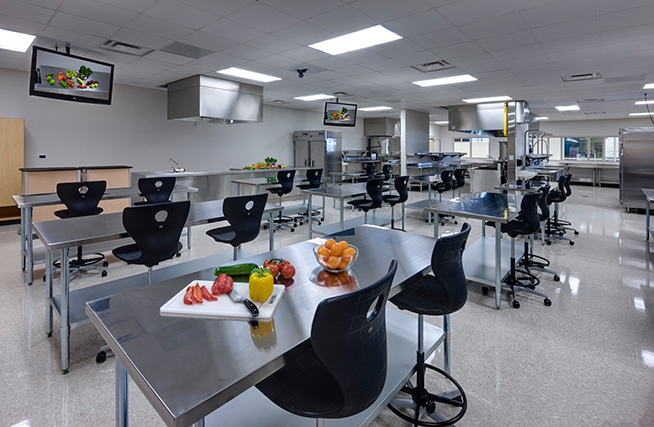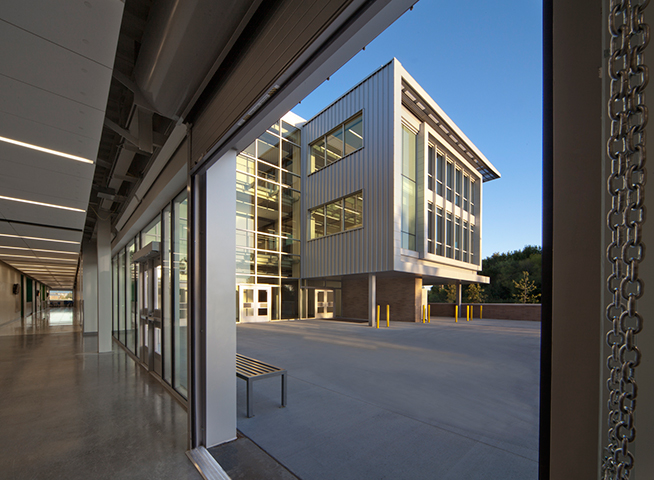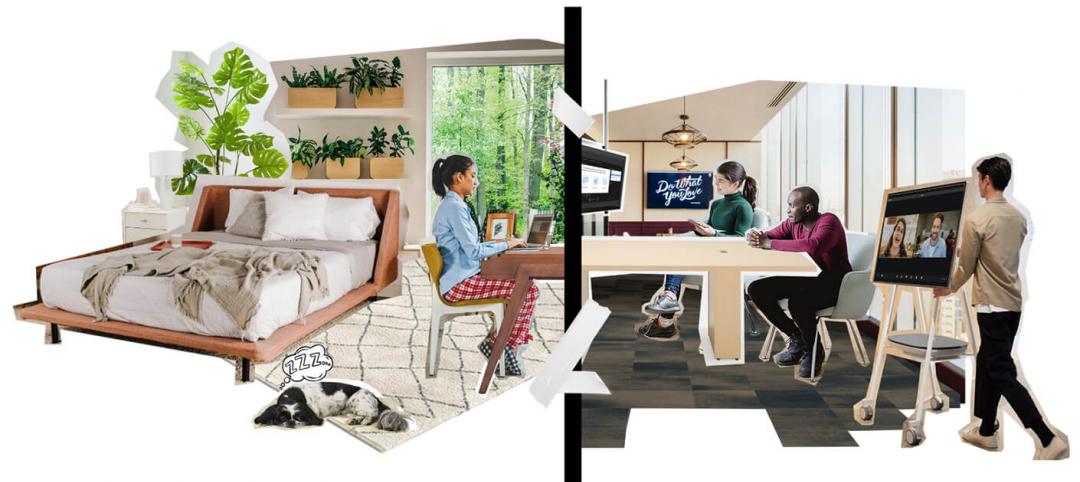It’s no secret: the way students learn today is different. Curriculum is shifting, subjects are blending, and methods for engaging students are changing – but are facilities adapting to the increasing demands of technology, collaborative learning, and project-based instruction? In many cases, yes.
School districts today are beginning to take cues from innovative companies and think-tanks like Google and IDEO, where collaboration among peers occurs within messy, flexible and sometimes loud space. Having a place where teams of students can design and build is becoming an essential part of educational spaces.
In my own high school days in the late 1980s, these types of spaces were not located within the main high school. Spaces for woodshop, agriculture, ROTC and other programs stereotypically known as “vo-tech” (as in vocational) were located in separate, stand-alone and sometimes low-cost, temporary buildings located toward the back (or the hidden side) of the school campus. During that era, those programs were necessary but not sought after by the school’s academic elite.
Today, these programs are celebrated by school administrators and officials as being case studies in "authentic learning" or Project-Based Learning (PBL), and research and data now show how students benefit from blended programs and learning models. Career and technical education programs have begun to dominate high school curricula throughout the country.
Career strands such as animal science, architecture + construction, bio-mechanics + robotics, cosmetology, culinary arts, digital animation + broadcast, engineering, horticulture, human services, journalism + graphic design, medicine + health sciences and transportation demand unconventional learning environments, as do the many STEM and STEAM (science, technology, engineering, arts, and mathematics) learning labs already being incorporated in many public high schools throughout the country.
Although these blended subjects and learning spaces are unconventional compared to the types of classrooms Baby Boomers and some Gen X-ers may be accustomed to from our days at the chalkboard, these programs and learning models will help prepare students for an ever-demanding and global society—whether they plan to attend college or go directly into the workforce.
 Image courtesy of Perkins+Will
Image courtesy of Perkins+Will
Learning Transformation
So what does this shift mean for facility planning and design? It’s not a complete physical transformation as much as it is a behavioral one. Most of these types of spaces still have four walls and a ceiling, but the types of group collaboration and learning activities that happen within these walls are changing. Learning environments such as makerspaces and STEAM learning labs provide students and teachers a hands-on and collaborative way to design, invent, experiment and most importantly build school projects. These environments deeply and creatively support the blending of science, technology, engineering, art and mathematics, which has been the fundamental philosophy of vocational and career and technical education (CTE) programs.
A makerspace is not just a science lab or a woodshop. It’s neither a computer lab nor an art room; it’s all of these identities in one single, blended environment. Thoughtful consideration must be given to accommodating a diverse range of activities, tools, materials and student assignments. Group collaboration and cross-pollination of tasks are essential to the learning and exploration process. It’s these elements and learning characteristics that set makerspaces and STEAM learning labs apart from their 20th-century predecessors and outdated, single-subject classrooms.
 Image courtesy Perkins+Will
Image courtesy Perkins+Will
Flexibility, Changeability, Adaptability
Designing a space to accommodate such a wide range of activities can be a challenging process. Delicate research and planning efforts are critical in designing a learning environment supportive of multiple learning objectives, but the single greatest planning principle seen in many of today’s successful vocational and CTE learning spaces is flexibility.
Change is inevitable: we all know it is going to happen, but sometimes we just don’t know when. When exploring the physical aspects of such a learning space, considerations should include not only moveable student furniture and storage, but also furniture that can be arranged in a variety of ways, adaptable to large group interaction, small group activities and single person assignments. Project areas should be open with simple geometries that are free of tight corners combined with appropriate height and volume allowing projects to flex between small individual assignments to large, complex group projects.
Access to project areas should also provide ample room for material delivery and product mobility. The learning environment should be easily changeable and quickly adaptable, possibly maximizing movability by having everything on wheels. Building and utility infrastructure such as power, data and plumbing should be carefully positioned to provide immediate and finger-tip access, while cords, devices and other mobile equipment can be easily tucked away during non-use. Technology should also be wireless, nimble and integrated into the learning process and the environment.
Because innovative and blended learning environments such as makerspaces are meant to be experimental project laboratories, building materials and finishes should be durable and minimal. Sealed or polished concrete floor slabs are preferred for ease of cleaning due to the inevitability of spills and experimental messes.
Finished ceilings should be limited, and open-to-above structure common place, exposing lighting, mechanical ducts, equipment, power runs and other necessary building infrastructure to support the project-based learning process. Walls should also be kept minimal, free of clutter and layered in writable surfaces to allow students to draw, diagram and collaborate within peer groups to further enhance the learning process.
Transparency and connection to adjacent and secure outdoor project areas are equally important, as many project-related activities require either more ample work space or include equipment or gasses that are not suitable for indoor use. With increasing construction costs and labor demands, these types of minimal learning spaces can also help school districts save on initial construction costs and annual operational and maintenance budgets.
Encouraging imagination, allowing students to be messy, understanding projects may be loud, and promoting project-based creativity are essential in today’s successful collaborative learning environment. These types of spaces should be viewed as a student’s “playground.” Makerspaces were created to do just that: they are a place to learn, design, to collaborate without rules, to explore new inventions, to dissect at times, and to build during other times. These unconventional learning labs are our new Vo-Tech, and unlike in past years, these programs and facilities are being celebrated and pursued. They are now seen as the cornerstone of our future educational model, where students can collaborate and learn through authentic, project-based, real-world experiences.
A version of this article originally appeared in School Planning & Management.
About the Author: Patrick Glenn is the K12 Regional Practice Leader for Perkins+Will in Texas and currently works in the Dallas office. With nearly two decades of educational leadership, planning and architectural design experience spanning more than 80 schools projects from across the state of Texas, Patrick offers unique expertise to help foster creative, organized and long term design strategies to better enhance the student learning environment.
 Image courtesy Perkins+Will
Image courtesy Perkins+Will
More from Author
Perkins and Will | Sep 19, 2023
Transforming shopping malls into 21st century neighborhoods
As we reimagine the antiquated shopping mall, Marc Asnis, AICP, Associate, Perkins&Will, details four first steps to consider.
Perkins and Will | Jul 20, 2023
The co-worker as the new office amenity
Incentivizing, rather than mandating the return to the office, is the key to bringing back happy employees that want to work from the office. Spaces that are designed and curated for human-centric experiences will attract employees back into the workplace, and in turn, make office buildings thrive once again. Perkins&Will’s Wyatt Frantom offers a macro to micro view of the office market and the impact of employees on the future of work.
Perkins and Will | May 30, 2023
How design supports a more holistic approach to training
For today’s college athletes, training is no longer about cramming team practices and weight lifting sessions in between classes.
Perkins and Will | Dec 20, 2022
4 triage design innovations for shorter wait times
Perkins and Will shares a nurse's insights on triage design, and how to help emergency departments make the most of their resources.
Perkins and Will | Aug 30, 2021
The great re-shuffle & re-think
In this new hybrid environment in which we cater to how our employees work best, how will we manage new hybrid work practices and etiquette?
Perkins and Will | May 18, 2020
Global design firms collaborate on new COVID-19 mobile testing lab to bring testing to vulnerable communities worldwide
Perkins and Will, Schmidt Hammer Lassen Architects, and Arup Group develop scalable solutions for increased testing capacity within high-density and under-served neighborhoods.
Perkins and Will | Jun 7, 2019
Workplace wellness: Top 3 tips for Fitwel certification
How can thoughtful design encourage healthier choices, lifestyles, and work environments?
Perkins and Will | Feb 27, 2019
ResilientSEE: A framework to achieve resilience across scales
Conceived in the Boston studio of Perkins+Will, the ResilientSEE team developed a resilient planning framework that can be applied to other neighborhoods, cities, and countries.
Perkins and Will | Nov 28, 2018
Amazon HQ2 and the new geography of work
The big HQ2 takeaway is how geography and mobility are becoming major workplace drivers.
Perkins and Will | Sep 4, 2018
It takes more than money to fund resilience
Resilient design, much like all projects in the built environment, requires funding.
















